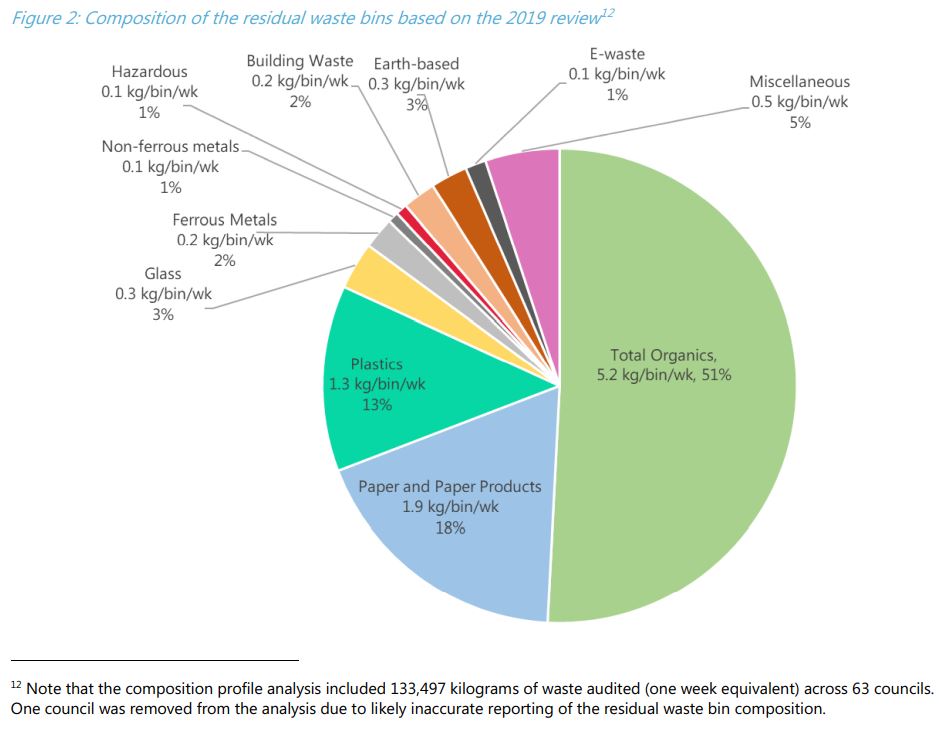Why study waste?
Kerbside bin studies provide valuable information for Council. They enable us to tailor our education messages to the community and provide robust data to inform and assist Council in improving future services to our community. For example, if studies find a large amount of organic waste in the red-lidded bins, Council can look at different strategies to handle that waste in a more efficient manner.
What’s involved?
The study process involves Council contracting a waste study firm to collect the bin contents from about two hundred randomly selected households per bin type. During the sample collection week, early each morning prior to the normal collection, a separate collection truck will arrive at the selected property and empty each bin’s contents into large bags. The bags will be taken to the Muswellbrook Waste & Recycling Facility where a sorting zone will be set up for the surveyors to weigh, sort, identify, categorise and document the composition of the bin contents.
The process is done in a fully confidential manner and, post-study, all non-recyclable waste is landfilled and recyclables are recycled.
What about privacy?
Your waste and your privacy is protected at all times.
The following information reflects Council’s confidence in this process:
- The methodology which we are required to use has been developed by the state government to provide robust and reliable data.
- Individual property addresses are not reported at any point in the survey process. Collected waste is given an independent code that is used only to determine general waste trends.
- We only engage highly experienced consultants who have collected and sorted waste over many years. We have confidence in their staff, their approach and their ability to deliver high quality data in a professional manner.
- When sorted and recorded, all collected materials are either sent to landfill or recycled through the Muswellbrook Waste and Recycling Facility.
- All consulting staff are required to sign a confidentiality agreement that is legally binding.
- The consultants have been advised of the importance of data privacy as outlined in Council’s Privacy Management Plan, which addresses the legislation provisions of the Privacy and Personal Information Act 1998.
If you would prefer to opt out of these bin studies, you can call Council on 6549 3700 during the advertisement period.
2024 bin study results
The waste study conducted followed the NSW EPA Guidelines for household kerbside waste, recycling and garden organics audits. The samples were collected on regular collection days before the kerbside trucks serviced the bins, ensuring adherence to industry best practices for WHS conformance, confidentiality and privacy. The study is aimed to monitor waste composition and recycling generation by weight, using a random selection of households in each collection zone to represent the area accurately. The project included 220 waste samples, 221 recycling samples, and 231 garden organics samples.
The pre-collection bin surveys involved a visual assessment to capture data on presentation rates and the percentage of bins full across waste streams. The collection process used a bagging technique where samples were carefully collected, labelled, and transported to a designated sorting site at the Council’s waste facility. At the sorting site, each bin’s contents were individually sorted and weighed, with the materials categorised into various waste types, including paper, plastics, metals, glass, organics, e-waste, hazardous items, textiles, inert materials and other specified items.
The study revealed a reduction in contamination rates for both recycling and garden organics compared to 2022. Recycling contamination improved from 15.50 % to 13.63%, while garden organics contamination decreased from 4.8% to 4.28%. The data showed that non-recyclable plastics constituted the largest contamination category in recycling bins, increasing from 8.66% to 15.28%. The average weekly waste generation per household also reduced from 10.02 kg in 2022 to 8.41 kg in 2024. Recommendations included enhancing education campaigns to address common contamination issues and implementing programs to recover specific waste types, such as textiles and soft plastics.
Risk management was a crucial aspect of the project, with steps taken to identify hazards, assess risks, and implement control measures. WHS procedures were rigorously followed, and various safety forms were completed to ensure a safe working environment. Confidentiality was maintained throughout the project, with aggregated data reported and no addresses listed in the findings. The study provided valuable insights into waste generation and contamination, offering a basis for future improvements in waste management practices.
Kerbside Bin Study 2024
Kerbside Bin Study 2022



